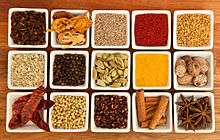Anglo-Indian cuisine
| Part of a series on |
| British cuisine |
|---|
| National cuisines |
| Overseas/Fusion cuisine |
|
 |
| This article is part of the series |
| Indian cuisine |
|---|
|
Regional cuisines
|
|
Ingredients, types of food |
|
See also
|
|
Anglo-Indian cuisine is the cuisine that developed during the British Raj in India, as the British wives interacted with their Indian cooks.[1]
The cuisine introduced dishes such as kedgeree, mulligatawny and pish pash to English palates. One of the few Anglo-Indian foods that has had a lasting impact on English cuisine is chutney.
Anglo-Indian cuisine was brought to England in the 1930s by the Veeraswamy restaurant, followed by a few others, but not by typical Indian restaurants.
History
Anglo-Indian cuisine was documented in detail by the English colonel Arthur Robert Kenney-Herbert, writing in 1885 to advise the British Raj's memsahibs how to cope with their Indian cooks.[1][2] Many of its usages are described in the "wonderful"[1] 1886 Anglo-Indian dictionary, Hobson-Jobson.[1] More recently, the cuisine has been analysed by Jennifer Brennan in 1990 and David Burton in 1993.[1][3][4][5]
Dishes
Well-known Anglo-Indian dishes include chutneys, salted beef tongue, kedgeree,[6] ball curry, fish rissoles, and mulligatawny soup.[1][7][8]
Chutney, one of the few Anglo-Indian dishes that has had a lasting influence[1] on English cuisine, is a cooked and sweetened but not highly spiced preparation of fruit, nuts or vegetables. It borrows from a tradition of jam making where an equal amount of sour fruit and refined sugar reacts with the pectin in the fruit such as sour apples or rhubarb, the sour note being provided by vinegar. Major Grey's Chutney is typical.[9]
Pish pash was defined by Hobson-Jobson as "a slop of rice-soup with small pieces of meat in it, much used in the Anglo-Indian nursery." The name comes from the Persian pash-pash, from pashidan, to break. A version of the dish is given in The Cookery Book of Lady Clark of Tillypronie of 1909.[1]
Restaurants
Some early restaurants in England served Anglo-Indian food, such as Veeraswamy in Regent Street, London, followed by their sister restaurant, Chutney Mary, opened in 1990.[10] E.P. Veeraswamy described his "Indian Cookery" in a book of that name in 1936.[11] Many Indian restaurants, however, have reverted to the standard mix-and-match Indian dishes that are better known to the British public.
References
- 1 2 3 4 5 6 7 8 Alan Davidson (2014). Tom Jaine, ed. The Oxford Companion to Food (3rd ed.). Oxford: Oxford University Press. pp. 21–22. ISBN 0-19-967733-6.
- ↑ Wyvern (1994) [1885]. Culinary Jottings for Madras, Or, A Treatise in Thirty Chapters on Reformed Cookery for Anglo-Indian Exiles (Facsimile of 5th ed.). Prospect Books. ISBN 0-907325-55-6.
- ↑ Brennan, Jennifer (1990). Encyclopaedia of Chines and Oriental Cookery. Black Cat.
- ↑ Jennifer Brennan (1990). Curries and Bugles, A Memoir and Cookbook of the British Raj. Viking. ISBN 962-593-818-4.
- ↑ Burton, David (1993). The Raj at Table. Faber & Faber.
- ↑ "Sustainable shore - October recipe - Year of Food and Drink 2015 - National Library of Scotland". nls.uk.
- ↑ Roy, Modhumita (7 August 2010). "Some Like It Hot: Class, Gender and Empire in the Making of Mulligatawny Soup". Economic and Political Weekly. 45 (32): 66–75. JSTOR 20764390.
- ↑ "Cooking under the Raj". Retrieved 30 January 2008.
- ↑ Bateman, Michael (17 August 1996). "Chutneys for Relishing". The Independent. Retrieved 26 September 2016.
- ↑ Vaughan, Tom (12 July 2007). "Indian restaurants: Where it all started and where it's all going". The Caterer. Archived from the original on 16 November 2015. Retrieved 26 September 2016.
- ↑ E.P. Veeraswamy (1936). Indian Cookery: For use in all countries. London.
Further reading
- Patricia Brown. Anglo-Indian Food and Custom. ISBN 0-14-027137-6.
- Henrietta Hervey (2006) [1895]. A Curry Book (Anglo-Indian Cookery at Home). Ludlow: Excellent Press. ISBN 978-1-900318-33-4.
- Pat Chapman (1997). Taste of the Raj. London: Hodder & Stoughton. ISBN 0-340-68035-0.
External links
- "Food Stories" — Explore a century of revolutionary change in UK food culture on the British Library's Food Stories website
- "How Britain got the hots for curry". BBC News Magazine. 26 November 2009. Retrieved 15 August 2014.
- "Fears for the decline of Anglo-Indian cooking". BBC News Online. 7 February 2011. Retrieved 15 August 2014.